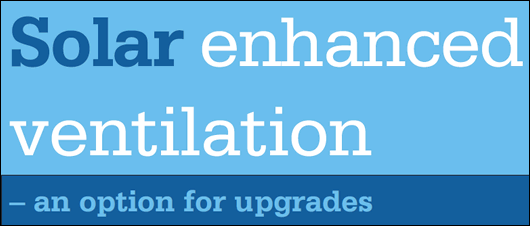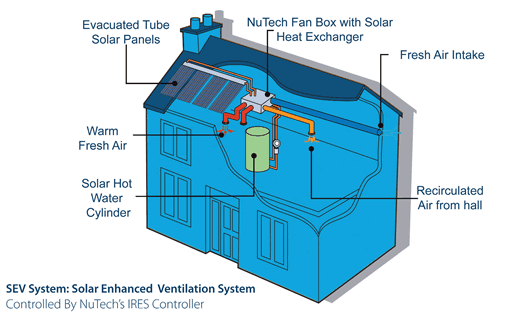- Ventilation
- Posted
Solar enhanced ventilation

Designed and patented by Irish firm NuTech Renewables, solar enhanced ventilation aims to bring big energy and cost savings to the retrofit market by combining solar and ventilation technologies. NuTech’s Bill Quigley explains how it works.For over 25 years myself and Mark Forkin, the founders of NuTech Renewables, have been designing and building low energy new dwellings. We have developed and installed our unique Passive Solar House heating and ventilation system in hundreds of houses.
But four years ago we could see the new house market beginning its inevitable decline. The market, along with government policy, was going to redirect its focus to the existing house sector. We quickly realised that unless an existing house was completely gutted, our Passive Solar House system would be a non-runner. We also knew that a typical solar water heating system does not have a truly satisfactory payback when properly calculated. We saw this situation as an opportunity and quickly decided to spend time, effort and money on the necessary R&D to develop a product that would deliver more useful solar energy to the house in order to boost payback for the homeowner, while also improving atmosphere and comfort.
We invented and patented Solar Enhanced Ventilation (SEV), a system that delivers solar energy by way of a positive input ventilation (PIV) system, while also delivering solar hot water. The system features a larger solar array and a slightly larger solar hot water storage tank. In effect, by doubling the solar array and using the larger cylinder, about three times the amount of solar energy is delivered to the house compared to standard solar water heating. It’s worth noting that this system delivers solar energy to the house and the enlarged storage cylinder by day. By night NuTech’s specially designed Intelligent Renewable Energy System (Ires) controller takes heat from this cylinder and delivers it to the house by way of the ventilation system. Delivering three times the amount of free energy means the payback on the investment is dramatically improved.
The internal rate of return (IRR) with this system is in fact doubled – up to 8% in a typical situation. This means a homeowner is far better off to invest in this technology than leave money deposited in a bank. This 8% IRR – which is a 100% improvement on the investment compared to a solar water heating only installation – is achieved when taking the SEAI Better Homes grant into account, which Construct Ireland readers will know is only available to the existing house market.

An illustration showing the key elements of NuTech’s solar enhanced ventilation system
The affect on the BER of the house is also quite dramatic. This is because energy savings are much greater, as the SEV system delivers energy to both the space heating and hot water systems. PIV systems are also favourably treated in SEAI’s Deap calculation procedure – in effect, our system delivers the same result as installing typical solar water heating together with heat recovery ventilation. And all of this comes at a much reduced cost and without pulling the house apart. Plus, with our SEV system, the building regulations requirement of achieving 10 kWh/m2/a from renewable sources can be achieved even in larger houses. The homeowner can also interrogate the SEV system using the highly visual display panel of the (Ires) controller.
NuTech has always been concerned that when an existing house is renovated, the ventilation rate may be dramatically reduced. This makes it essential to consider a ventilation system when retrofitting. Our SEV system dramatically improves the ventilation rate in the house, and without an energy penalty. With positive input ventilation the house is also slightly pressurised – this, together with the extra ventilation, can improve the situation when radon gas levels are above normal.
We’re intent on delivering this system to the Irish and the British existing house market where we see that significant energy, carbon and money savings can be made. In the Irish market we welcome SEAI’s requirement of having to achieve 10 kWh/m2 per year from renewable sources as this ensures systems are properly designed in the case of smaller houses, and creates a need for systems such as SEV in the case of larger dwellings. The downside is that some people may be tempted to use cheap “black market” solar products that are inferior and unregistered. These inferior systems will not qualify for the SEAI grant, nor will they satisfy SEAI’s technical requirements, nor will they carry any legally enforceable guarantee.

